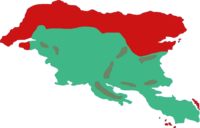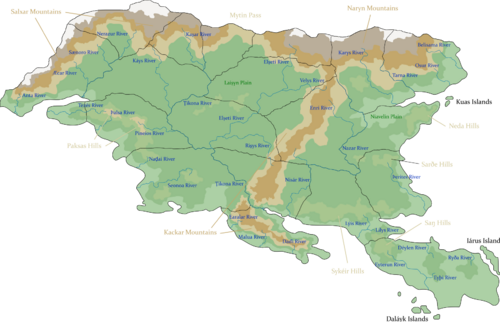Battles of Nerazur and Mytin
| Battles of Nerazur and Mytin | |||||||
|---|---|---|---|---|---|---|---|
| Part of the Liberation War | |||||||
Location of the battles of Nerazur and Mytin (modern-day regional borders overlaid) | |||||||
| |||||||
| Belligerents | |||||||
|
|
| ||||||
| Commanders and leaders | |||||||
|
|
| ||||||
The twin battles of Nerazur and Mytin were major engagements of the Liberation War between the forces of the Free Territories and Xevden under the Tymzar–Nalo regime. They were fought on 14–15 April 1948 in two separate locations: the Nerazur River (in modern-day Salxar), and the Mytin Pass (in modern-day Gacar).
The Free Territories obtained a decisive victory that gave them the strategic initiative for the remainder of the war.
Background

During the first phase of the Liberation War, the Free Territories had maintained a primarily defensive posture, expanding slowly by allying with like-minded rebellions and integrating liberated territory into the Free Territories. The Nerveiík Kingdom maintained a similarly defensive approach out of necessity, concentrating on survival, consolidation, and reorganisation.
A coup d'état on 31 December 1947 overthrew the Nerveiík Kingdom, with power seized by the Tymzar–Nalo regime. The regime launched a major offensive in February 1948, beginning the second phase of the war. Although it scored easy defeats against the fractious Gylian forces and advanced northwards, it floundered against the Free Territories.
Under the command of Raira Sano, the Free Territories forces undertook a strategic retreat and used attrition warfare and guerrilla warfare tactics. This incensed its leaders, Tymzar and Nalo Ðari, who were impatient and pushed for relentless offensives, seeking to deliver a death blow to the Free Territories.
Combatants
Free Territories
The Free Territories' military arm was the People's Army. It was known for its decentralised organisation, egalitarianism, and "revolutionary discipline". Particularly after Alscia had joined the Free Territories, it had developed creative and convoluted compromises to reconcile its democratic militia character with the conventionally-trained soldiers that came from the Border Guard.
Raira Sano was recognised as the commander-in-chief of the People's Army at the time of the battles. Her strategy was to avoid open battles with the Xevdenites until the right moment. Instead, the People's Army strategically retreated northwards, and used guerrilla warfare tactics to disrupt the Xevdenites and their supply lines.
Raira's specific plan, which had been approved by People's Army units and overseen by elected commanders on the field, was to execute a pincer movement leading to an encirclement. The Xevdenites were to be lured into battle on ground most advantageous to the Free Territories. Their supply lines would be destroyed and they would be ambushed and encircled.
Xevden
Xevden's military was the Royal Army. The Tymzar–Nalo regime had inherited a modern, well-equipped, professional army in the form of the National Army. Tymzar and Nalo had implemented a purge and hasty reorganisation, causing chaos in its ranks, and had suffered a loss of international support that affected its ability to secure supplies and equipment. However, at the time the Royal Army still had the greater professional organisation.
Tymzar and Nalo were impatient and meddlesome leaders. Their battle plans were coloured by hubris, believing that the Free Territories were disorganised and could be "mopped up" as easily as the other Gylian factions on the mainland had been overrun.
The battles involved two Royal Army army groups. One, commanded by Ero Leri, was advancing towards the west. Another, commanded by Rys Lesea, was advancing north, towards the Mytin Pass. Tymzar and Nalo hoped that by capturing the Mytin Pass, they could split the Free Territories in two and thus destroy them.
The Royal Army was accompanied by the Storm of Steel, the paramilitary arm of the Revolutionary Front for Patriotic Victory. There was great tension between the two. The Royal Army despised the Storm of Steel as bloodthirsty fanatics, more concerned with terrorising and killing Gylians than military considerations. The Storm of Steel saw the Royal Army as "decadent" and lacking the ruthlessness necessary to win the war.
Battle
Raira's plan was bolstered by a significant military deception operation, with an important contribution from the 15th Special Operations Squad. The People's Army managed an orderly retreat and concealed their intentions, fooling the Royal Army into thinking that they were disorganised and fleeing.
In preparation for the battle, the People's Army and guerrillas behind the front lines concentrated on destroying the Xevdenite supply lines. The Gylian counterattack was delayed in order to make sure the Xevdenites had sufficiently outrun their supply lines and were dangerously separated from the rest of their military forces.
The attack was launched on 14 April 1948, and lasted two days.
Mytin
Rys Lesea was uneasy with the advance towards the Mytin Pass. He felt it brought the Royal Army dangerously close to the border with Knichus, and feared provoking war with Cacerta. However, the advance continued under pressure from Xevdenite leadership and the accompanying Storm of Steel.
The People's Army had extensively prepared an ambush in the pass. Artillery units had been set up and concealed in the Salxar and Naryn mountains overlooking the pass. Rest periods and rotations of front-line units meant that the Free Territories' forces were well-prepared and had high morale, in contrast to the exhausted Xevdenites.
The People's Army opened a fierce bombardment on the Royal Army camp. Lasting three hours, the artillery barrage stunned and disorganised the Royal Army. The People's Army battalions then attacked, encircling the camp and cutting off all routes of escape.
Judging the situation to be hopeless, Rys chose to avoid a suicidal fight to the death. He surrendered to the People's Army commanders. One of them recalled the scene:
"The white flag fluttered above the encampment. The Xevdenites were disarmed, and we agreed to terms. Some of our soldiers took the opportunity to jeer and mock them. We transported the Xevdenite soldiers to our nearest bases and villages, to be attended to and protected as prisoners of war. The Storm of Steel, our soldiers simply shot the bastards on the spot. Some yelled that they had avenged loved ones and family members while shooting. They had given no quarter, and received no quarter. I remember hearing one soldier yelling at another to not waste bullets on the Storm of Steel."
Nerazur
The People's Army had prepared for an ambush at the Nerazur River. Most of its bridges had been destroyed, and the only one left standing had been covertly lined with explosives.
The Royal Army began crossing the Nerazur. During its crossing, the People's Army secretly detonated the explosives, blowing up the bridge and surprising the Xevdenites. They then encircled the Xevdenites on both sides of the river.
Xevdenite commander Ero Leri was captured during the battle. Disorganised and encircled, the Royal Army was easily defeated.
Aftermath
The battles were a decisive victory for the Free Territories. With the victory, the initiative passed firmly to the People's Army. For the remainder of the war the Xevdenites were limited to reacting to Free Territories advances, and were never able to regain the initiative or launch a major offensive.
Xevden's victories against the other Gylian factions proved disastrous in the long run. The decimation of the other Gylian factions drove them to unite behind the Free Territories, making the second phase of the war a straightforward Free Territories–Xevden conflict. Additionally, international opinion was so repulsed by the Tymzar–Nalo regime's conduct and war crimes that various Tyranian countries supported the Free Territories as the "lesser evil". Acrea's switch in support to the Free Territories set an influential precedent.
Although Tymzar and Nalo had determined the broad aims of the Xevdenite offensive, they blamed the Royal Army commanders for the defeat. Their interference in military matters progressively increased as they grew more paranoid.
Following the defeat, the RFPV and Storm of Steel underwent a process of cumulative radicalisation. Trapped in a war of annihilation they had launched and rendered international pariahs, they became obsessed with destroying all perceived enemies and "traitors". They launched the Xevdenite Terror, a campaign of destruction and massacres that lasted throughout the second phase of the war.
This made them especially hated by the Free Territories, and reprisals and war crimes against them were tolerated; RFPV and Storm of Steel prisoners were summarily executed and their corpses dumped in public squares to be abused by passersby, or hung by lamp-posts with wooden boards attached detailing their crimes.
